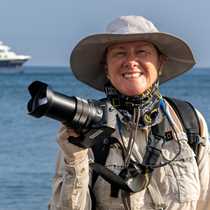Pacaya River
The Pacaya River is one of the three principal rivers that drain the Pacaya-Samiria National reserve flood forest area. About 5 million hectares in area (~2 million acres, just about the same as the Peruvian sole exchange rate with the dollar), it is the largest reserve in Peru, and the third largest protected region in the Amazon. The ecosystem is entirely “flood forest,” meaning that it spends almost half the year underwater. As we cruise along in the skiffs, we can see the watermark on the trees, at least 15 feet higher than where we sit now.
Using the Pacaya River, we can access the interior fairly quickly—it’s a deep river with good flow and few obstacles like tree trunks and branches that can be troublesome in the smaller rivers. This morning we set off early—in fog! When I woke up, I could barely see the bank or tree we were tied to. Reassured by our local experts that this wouldn’t last long, and would in fact burn off into a hot day, we set off in the skiffs and made our slow way up river looking for wildlife.
Gradually the fog lifted until it became exactly what they said it would be: a very hot, sunny day. But before the sun really got going, we had seen some of the marvelous inhabitants of the flood forest: horned screamers booming away, Cocoi herons (skittish), many parrots, wood storks catching the thermal overhead, blue and yellow macaws, and finally the exotic hoatzins. These birds have to be seen to be believed. A crest that stands tall and feathery, blue skin around the eyes, rufous and brown-black feathers on the back, and fluffy “pantaloons” of rufous feathers around their undersides and legs.
These leaf-eaters are not particularly good fliers, and spend their mornings perched until the sun warms them up a bit. We found them grumbling, squawking, buzzing together in a large group overhead and watched. No chicks were in evidence because it wasn’t a nesting location. Nests are normally on branches over water so the chicks can escape predators by falling into the water, swimming back to the base of the tree, and climbing back into the nest. This amazing behavior is unique to the hoatzin, and the chicks are born with claws on their “elbows” to aid in the climb.
The sun brought out the Pacaya-Samiria National Reserve river turtles. As we zipped by in the skiff on our return, we saw many yellow-spotted turtles and the “charapa” turtles as well. It was for the protection of these species and others highly endangered, that the reserve was first established. Originally, it was just the Pacaya River drainage that was declared a reserve in 1940 in order to protect the largest freshwater fish in the world, the “paiche” or Arapaima gigas. Today the protected area encompasses so much more, both geographically and biologically.
The afternoon was spent heading once more up the Pacaya River in order to get as far inside the reserve as we possibly could in the time given. Yanayacu Lagoon is about 29 km river miles from the Pacaya mouth on the Ucayali, however as the bird flies it is only 8.5 km. For those who accept the journey, the rewards are great. Today we saw howler monkeys, monk saki, squirrel monkeys (in a huge troop), and one lucky group got the additional sighting of white-fronted capuchin monkeys! The jabiru stork put in an appearance fishing along the borders of the lagoon. It caught an armored catfish (these fish are the main diet of so many species it’s hard to imagine) but had quite a time getting it down.
The swimming group had a wonderful time in the black-water lagoon with pink dolphins circling us at a distance. In the silence of Amazon, the breathes of air being taken by the dolphins carried well, making us think they were right next to us when in actuality they kept a discreet distance of at least 10 meters (although once I saw bubbles appear suspiciously close by).
By sunset the colors in the sky were reflected in the still waters of the Pacaya. By nightfall we were pulling up to the ship, our home-away-from home and a welcome sight after so much time travelling to this far-off world of wide open skies, tall trees and quiet water.



